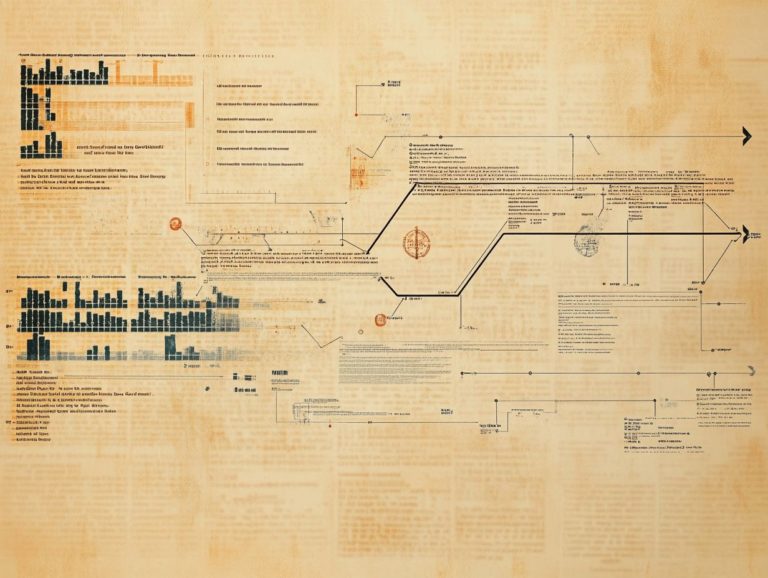What is a Provisional Patent? Key Facts You Should Know
Navigating the realm of intellectual property can indeed feel overwhelming, particularly when you re focused on protecting your groundbreaking ideas. A provisional patent presents a strategic opportunity to safeguard your inventions while giving you the necessary time to refine and perfect them.
This article delves into the intricacies of provisional patents, guiding you through the filing process and highlighting the benefits they offer, as well as their limitations and key considerations. It also explores alternative forms of protection, ensuring you re equipped with the insights needed to make informed decisions regarding your intellectual property.
Contents
- Key Takeaways:
- Understanding Provisional Patents
- The Process of Filing a Provisional Patent
- Benefits of Filing a Provisional Patent
- Limitaciones de las Patentes Provisionales
- Consideraciones Importantes para las Patentes Provisionales
- Alternativas a las Patentes Provisionales
- Preguntas Frecuentes
- Qu es una Patente Provisional?
- Cu l es el prop sito principal de una Patente Provisional?
- Cu les son los datos clave que debes conocer sobre las Patentes Provisionales?
- What are the requirements for filing a Provisional Patent?
- What happens after the one-year period of a Provisional Patent?
- Can a Provisional Patent be converted into a non-provisional patent?
Key Takeaways:
A provisional patent provides temporary protection for an invention, allowing the inventor to secure a filing date and “patent pending” status.
The process of filing a provisional patent involves specific steps and requirements, such as a written description and drawings of the invention.
Filing a provisional patent offers benefits such as protection from potential infringement and the ability to market and test the invention without losing patent rights.
Understanding Provisional Patents
Grasping the nuances of provisional patents is essential for inventors aiming to secure patent protection in the United States. A provisional patent application acts as a strategic placeholder, enabling you to obtain a priority filing date with the United States Patent and Trademark Office (USPTO) while you carefully prepare your non-provisional patent application.
This initial filing grants you a ‘patent pending’ status, offering protection for your invention for up to 12 months. During this crucial period, you can evaluate the market potential and gather the necessary resources for the next steps in your patent journey.
Definition and Purpose
A provisional patent is a type of patent application that acts as a preliminary step in securing protection for your invention. This temporary status allows you to preserve your invention’s filing date while you refine your ideas or seek funding.
It s important to note that a provisional patent isn t examined by the patent office and cannot lead to an enforceable patent on its own. This sets it apart from non-provisional patents, which undergo a thorough examination process and grant you exclusive rights for a specified period.
By understanding these distinctions, you can strategically leverage the provisional patent system to enhance your intellectual property portfolio while minimizing both costs and time during the development phase.
The Process of Filing a Provisional Patent
Filing a provisional patent entails several crucial steps that you need to grasp fully in order to navigate the intricacies of patent law with confidence. Understanding this process is essential for you as an inventor, ensuring that you can adeptly manage the complexities involved.
Steps and Requirements
To file a provisional patent, you must navigate a series of essential steps and adhere to specific requirements set forth by the USPTO. First, you need to prepare a detailed invention disclosure that comprehensively outlines your innovation. This involves describing how your invention works, its potential applications, and including any drawings or sketches that illustrate its design or operation.
Be aware that there may be filing fees involved, which can fluctuate based on factors such as your entity size whether you’re classified as a micro, small, or large entity.
To bolster your application, providing comprehensive information for claims writing is crucial. This includes highlighting the novel features of your invention, explaining how it stands apart from existing technologies, and detailing any advantages it offers.
Benefits of Filing a Provisional Patent
Filing a provisional patent application presents you with a multitude of advantages, especially if you’re keen on protecting your innovative ideas while adeptly maneuvering through the complexities of the patent process.
Protection and Advantages
One of the primary advantages of filing a provisional patent is that it grants you immediate patent pending status. Use this status as a powerful marketing tool, signaling to potential investors and partners that your invention is legitimate and backed by legal protections.
With the patent pending label, you enhance your credibility, making it easier to capture attention in competitive markets. By showcasing this status, you effectively differentiate your creation from the rest, instilling a sense of urgency and exclusivity.
Holding patent pending rights gives you the power to explore licensing opportunities while retaining control over your innovation, paving the way for strategic partnerships that could significantly amplify your market reach.
Don t wait! Start your provisional patent application today to safeguard your innovation.
Limitaciones de las Patentes Provisionales
Las patentes provisionales ofrecen muchas ventajas, pero tambi n tienen limitaciones espec ficas que debes considerar cuidadosamente antes de avanzar.
Lo que No Cubren
Las patentes provisionales tienen limitaciones, especialmente en lo que respecta a la protecci n integral bajo la ley de patentes. Carecen de reclamaciones espec ficas, que son cr ticas para definir el alcance de tu invenci n y evitar que otros la copien.
Esta ausencia de detalle puede dejarte expuesto, ya que una patente provisional no ofrece el mismo apoyo legal robusto que una solicitud de patente completa. Tambi n est el tema del arte previo; debes avanzar con cautela, ya que cualquier divulgaci n p blica o invenciones existentes podr an poner en peligro tus reclamaciones.
Por lo tanto, es esencial que cualquier persona que contemple este camino entienda lo que se excluye en una patente provisional para evitar errores costosos.
Consideraciones Importantes para las Patentes Provisionales
Al considerar la presentaci n de una patente provisional, debes tener en cuenta varios factores cruciales que pueden influir profundamente en tu estrategia de solicitud de patente.
Costos y Plazos
Los costos y plazos para presentar una patente provisional var an significativamente, y esta variabilidad juega un papel crucial en tu proceso de toma de decisiones.
Es esencial comprender estos elementos financieros, especialmente ya que la tarifa b sica de presentaci n para una solicitud provisional generalmente oscila entre $65 y $260, dependiendo del tipo de entidad que presenta la solicitud.
En contraste, las tarifas para solicitudes no provisionales a menudo superan los $300. No olvides los costos adicionales, como las tarifas de mantenimiento que se presentan a medida que la solicitud avanza en el proceso de revisi n de patentes.
El plazo es otro factor cr tico a considerar; las patentes provisionales te permiten asegurar una fecha de presentaci n por hasta un a o, mientras que las solicitudes no provisionales pueden tardar de seis meses a varios a os en recibir la aprobaci n final.
Al evaluar exhaustivamente tanto los costos como los tiempos de procesamiento esperados, puedes desarrollar una estrategia bien informada para gestionar tu propiedad intelectual.
Alternativas a las Patentes Provisionales
Los inventores que buscan alternativas a las patentes provisionales deben explorar diversas formas de proteger sus ideas que podr an ajustarse mejor a sus necesidades nicas.
Otras Formas de Protecci n de Propiedad Intelectual
Otras formas de proteger tus ideas incluyen patentes, marcas registradas, derechos de autor y secretos comerciales, cada una ofreciendo ventajas distintas. Comprender estos tipos puede mejorar significativamente tu enfoque estrat gico como innovador.
Las patentes act an como un escudo para tus invenciones, otorg ndote exclusividad que puede durar hasta 20 a os. Mientras tanto, las marcas registradas protegen los signos, logotipos o nombres nicos que ayudan a los consumidores a reconocer tus productos o servicios.
Los derechos de autor aseguran que tus obras originales ya sean literatura, m sica o arte est n protegidas, garantizando tus derechos como creador. Por otro lado, los secretos comerciales cubren informaci n confidencial de negocios, proporcionando una ventaja competitiva que muchas empresas aprovechan en sus procesos o f rmulas.
Elegir la forma de protecci n adecuada puede impulsar el potencial comercial de tus creaciones.
Preguntas Frecuentes
Qu es una Patente Provisional?
Una patente provisional es un tipo de solicitud de patente que permite a un inventor asegurar una fecha de presentaci n para su invenci n, brind ndole un a o para presentar una solicitud de patente no provisional.
Cu l es el prop sito principal de una Patente Provisional?
El prop sito principal de una patente provisional es establecer una fecha de presentaci n temprana para una invenci n sin tener que proporcionar una reclamaci n formal de patente o divulgaci n. Tambi n permite al inventor utilizar la frase “patente pendiente” en su invenci n durante el per odo de un a o.
Cu les son los datos clave que debes conocer sobre las Patentes Provisionales?
- Una patente provisional no es examinada por la oficina de patentes y no resulta en una patente otorgada.
- Es menos costosa y tiene menos requisitos formales en comparaci n con una patente no provisional.
- Proporciona al inventor una ventana de un a o para presentar una patente no provisional.
- Otorga al inventor tiempo para desarrollar y perfeccionar su invenci n antes de presentar una patente no provisional.
- No requiere un abogado o agente de patentes, aunque su experiencia puede ser beneficiosa en el proceso de presentaci n.
- Solo otorga al inventor una fecha de presentaci n y no proporciona ninguna protecci n legal para la invenci n.
What are the requirements for filing a Provisional Patent?
To file a provisional patent, you need a clear written description of your invention. Include any drawings or illustrations that help explain it, along with a filing fee.
You must submit this application to the United States Patent and Trademark Office (USPTO) to secure your filing date.
What happens after the one-year period of a Provisional Patent?
Once the one-year period ends, you must file for a non-provisional patent to keep your legal protection. If you miss this deadline, you ll lose your filing date and the benefits of your provisional patent!
Can a Provisional Patent be converted into a non-provisional patent?
Absolutely! You can convert a provisional patent into a non-provisional one by submitting the application within the one-year window.
Just make sure to claim the earlier provisional patent to keep your filing date intact.






